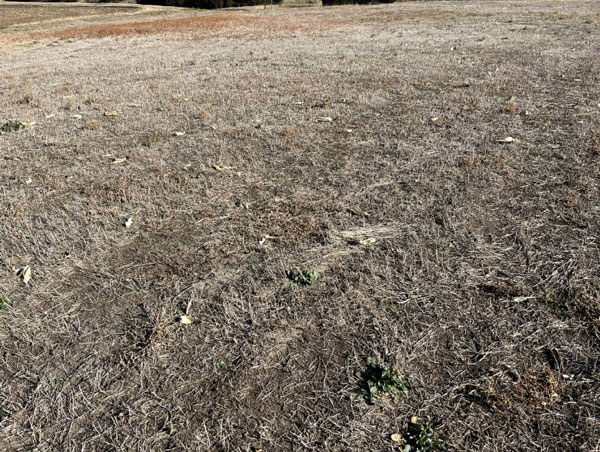This past year was challenging for brome producers throughout eastern Kansas, with many reports of a complete loss or partial loss of their brome stands (Figure 1). Brome field damage varied greatly, with some fields that appear dead while others have no damage at all. The majority of the damaged areas were late-harvested fields that were cut in mid-to-late July and after. Fall armyworm moths sought those recently harvested fields as sites to lay their eggs.

Figure 1. Dead brome field in eastern Kansas. Photo credit: Rod Schaub, K-State Research and Extension.
The brome plants tried to regrow (just a few inches tall) when the worms began feeding and within a couple of days, those fields turned brown. Hot, dry weather during this time led many producers to believe the burning fields were going dormant. However, questions arose after a few rain events in early September, and the brome wasn't greening up.
For now, producers need to identify the extent of damage that occurred in those fields. The first questions to be answered are: Are the brome plants alive or dead? Is there potential for regrowth?
If there are live rhizomes, it is likely that new tillers will be able to come up in the spring as environmental conditions improve. If there is no evidence that the plants are alive and the chances of regrowth are slim, producers need to plan for spring. In a “normal” year, with regular supply and input prices (seed, fertilizer, herbicide, etc.), the plan would be to calculate the damaged area and plan to have a well-prepared seedbed, and seed with 10 to 15 pounds of pure live seed (PSL)/acre. If a poor seedbed exists, seeding rates as high as 20 pounds PLS per acre may be required to obtain satisfactory stands. Higher seeding rates should be used when brome is broadcast on the surface and covered. In addition, there is a need to take soil samples and prepare a fertility program applying lime, nitrogen, phosphorus, and potassium as needed. More information on Smooth Brome production and utilization can be found at: https://bookstore.ksre.ksu.edu/pubs/c402.pdf
As noted above, 2022 is a year with agriculture supply chain issues. Brome seed is very limited and the cost reflects that limited supply. Thus, there may be a need to identify other forage options.
- If farmers need to produce forage during the spring and summer and are concerned with the cost of brome replanting (seed and fertilizer), they can consider exploring summer annual forages such as pearl millet, sorghum-sudangrass, forage sorghum, crabgrass, etc. These crops yield 4000 to 8000 lbs. of forage/acre. This is also an opportunity to consider seeding spring oats, spring triticale, and cereal rye with production from 1500 to 4000 lbs. of forage/acre. More details are available at: https://www.agronomy.k-state.edu/documents/extension/mf2871.pdf
- If brome production this spring/summer is not crucial, or the producer isn’t sure whether the brome is alive or dead, the grower can wait to see if the brome will come back during the spring and later decide what to do. With this option, farmers will have more time to determine stand health, identify prices trends, and make forage-based decisions. However, this option can also affect business profitability due to the uncertainty of forage yield during the next growing season.
- If a grower really needs to produce brome hay to be sold and the field is damaged or dead, he should identify the number of acres to be replanted and purchase seed, fertilizer (take soil samples for lab analysis before defining the fertility program), herbicide, and insecticide as needed. Keep in mind that brome can be established in the spring, but weed pressure will be high. After planting in the spring, producers should scout for armyworms and other insects. Spring-planted brome is generally not harvested until the following spring. Fall-planted brome can be harvested in the spring of the next growing season.
This damaged or dead brome situation will be very unique in each hayfield. Thus, what your neighbor is doing or decided to do does not necessarily apply to you and your hayfield. Analyze your field, check the plants, and decide what would be the best for your operation. Each field may require a unique solution.
Bruno Pedreira, Agronomist, Southeast Research and Extension Center
pedreira@ksu.edu